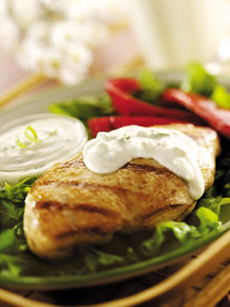 Chicken with yogurt sauce. Add dill, garlic, lemon zest and your favorite seasonings. Photo courtesy Wisconsin Milk Marketing Board. Chicken with yogurt sauce. Add dill, garlic, lemon zest and your favorite seasonings. Photo courtesy Wisconsin Milk Marketing Board.
September 2011
|
 |
Chicken Glossary: Chicken Types
Page 6: Chicken Terms N To R
This is Page 6 of a seven-page chicken glossary, including chicken types. Click on the black links below to visit other pages. Check out almost 100 other food glossaries: details on all of your favorite foods. Also see our Egg Glossary.
This glossary is protected by copyright and cannot be copied in whole or in part.
PECKING ORDER
Chickens operate under a distinct societal structure with social rankings for each bird. The boss, or alpha male, is the leader of the pack. He is in first position for everything from feeding to mating to fighting. The pecking order continues down to the very last rooster. There is also an alpha hen, following the same structure. You can watch a flock and determine the alphas, betas and the rest. In the absence of a rooster, the alpha hen may take on a more aggressive and dominant role among the flock, exhibiting behavior similar to a rooster.
PERCH or ROOST
Chickens sit and sleep on a perch, a horizontal pole or rod that rest enables them to rest in a elevated position with protection from ground predators. The name comes from the Latin pertica, long staff. The rooster often sits above the flock on his roost, giving rise to the expression “to rule the roost”: to be in charge or control. On the other hand, the phrase “chickens come home to roost”—a literal depiction of farm chickens that go out to forage during the day and return to the safety of the hen-house at dusk—took a more negative meaning, that you have to face the consequences of your mistakes or bad deeds, “as sure as chickens come home to roost.”
|
POPCORN CHICKEN
Small nuggets of chicken, the size of large popped popcorn kernels.
POULTRY
Chickens and other domesticated birds such as ducks and turkey, raised for food (meat or eggs) or as pets.
|
|
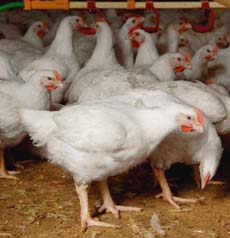
Tender young pullets, ready for sale. Photo courtesy Chicken.org.au. |
|
POUSSIN
Poussin, pronounced poo-SAHN, is a term used in Europe to describe a young chicken, fewer than 28 days old and weighing from about one to two pounds. In the U.S. it has been referred to as “baby chicken,” the stage between a chick (too small to eat) and a broiler or fryer of three to four pounds. Sometimes the term “poussin” is used erroneously in the U.S., to refer to the Rock Cornish hen, a crossbreed of the Cornish hen of Great Britain and the American White Rock hen. A Rock Cornish hen is a small breed of chicken. A poussin is a baby chicken of any breed. A Rock Cornish hen is about twice as old and twice as large as a poussin. So check the weight: If it’s more than two pounds, it’s probably a Rock Cornish hen. See also spring chicken.
|
|
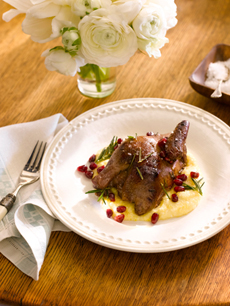
Poussin, a baby chicken. Photo courtesy Chicken.org.au. |
Why serve poussin? It’s an elegant way to serve a poultry course a part of a multi-course dinner. It gives diners enough meat to enjoy the recipe, but not too much so that they fill up.
PULLET
A female chicken younger than 12 months/one year old.
|
PUREBRED
The offspring of a hen and rooster of the same breed. A mixed breed is actually an intentional hybrid or a common barnyard chicken.
RANGE FED or FREE RANGE
Chickens that are allowed to graze freely, enjoying exercise and gaining flavor from worms, slugs and other insects.
|
|
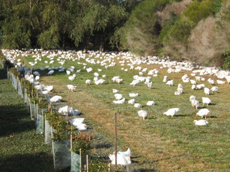
Free range chickens exercise their muscles, develop better textured meat, and eat worms and other bugs that enhance the flavor. Photo courtesy Chicken.org.au. |
|
ROASTER
Whole chickens are marketed by weight. A roaster is a cockerel or pullet, from three to five months in age and weighing 4 to 7 pounds. It is suitable for cooking whole in the oven or on a spit; or it can be quartered or otherwise divided. It is the best choice for roasting a whole chicken: It has the highest meat-to-bone ratio. See also broiler and stewing hen.
ROCK CORNISH HEN
An American crossbreed of the Cornish game hen with the American Plymouth Rock hen. It is not a “game” hen, but a cross between two domesticated chickens. See Cornish hen.
|
|
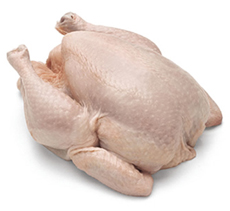
A tasty roaster from Lobels.com, a fine meat and poultry retailer in New York City. Photo © Lobels. |
|
ROOST or PERCH
The place where chickens spend the night and the rooster can perch during the day, to “rule the roost.” See perch.
ROOSTER
A male chicken; also called a cock. Many people around the world prefer to eat the gamier flesh of roosters. Roosters were the basis of coq au vin, a popular French farmhouse dish now made with chicken. Capons, or castrated young roosters, are another option more common in the U.S.
|
|
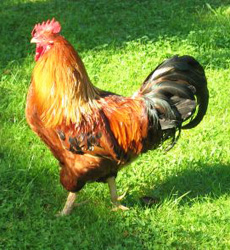
As in most species, the males are colored and plumed. The hens are typically drab. Photo by Matthias Lutsch | SXC. |
Continue To Page 7: Chicken Definitions S To Z
Go To The Article Index Above
This glossary is Lifestyle Direct, Inc. All rights reserved. Photos are the copyright of their respective owners.

|




 Chicken with yogurt sauce. Add dill, garlic, lemon zest and your favorite seasonings. Photo courtesy Wisconsin Milk Marketing Board.
Chicken with yogurt sauce. Add dill, garlic, lemon zest and your favorite seasonings. Photo courtesy Wisconsin Milk Marketing Board.



